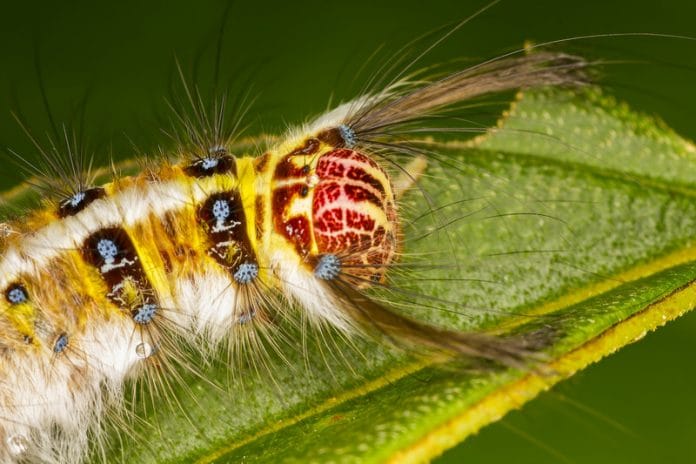The Ohio Department of Agriculture will soon begin aerial treatments to control the gypsy moth population in Ohio. Treatments are expected in early May, weather permitting, as larva and leaf development reach the optimal threshold.
The following areas will receive treatment:
• Hancock County, Arcadia;
• Hocking County, South Bloomingville;
• Licking County, Jersey;
• Seneca County, Tiffin.
 Treatments are administered using a low-flying aircraft that flies just above treetops. High humidity, low temperature and minimal wind are crucial for a successful application. Treatment will most likely take place during early morning hours.
Treatments are administered using a low-flying aircraft that flies just above treetops. High humidity, low temperature and minimal wind are crucial for a successful application. Treatment will most likely take place during early morning hours.
ODA will be using two kinds of treatments to control the gypsy moth caterpillar population, Foray (Btk) and Gypchek (NPV). Foray (Btk) is a naturally occurring bacterium found in the soil that interferes with the caterpillars’ feeding cycles. Gypchek (NPV) is a naturally occurring virus that affects only the gypsy moth caterpillar when ingested. Both treatments are not toxic to humans, pets, birds, bees or fish.
Ohioans can view maps of treatment blocks at ODA’s Gypsy Moth website. When the project begins, daily updates on treatment progress across the state will be available on the website or by calling 614-387-0907 or 614-728-6400. Currently, treatment areas are concentrated in central, northwest and southeast Ohio.
Gypsy moths are invasive insects that defoliate over 300 species of trees and shrubs. In its caterpillar stage, the moth feeds on the leaves of trees and shrubs and is especially fond of oak. A healthy tree can usually withstand only two years of defoliation before it is permanently damaged or dies. In Ohio, 51 counties are currently under gypsy moth quarantine regulations.
The damage from gypsy moth comes during its larval form. One 2 inch larvae can consume up to 1 square foot of foliage every 24 hours; each egg mass can contain 500-1000 eggs. In heavily infested areas, where there is 250 or more egg masses per acre, larvae can defoliate the infested trees. Repeated annual defoliation can result in the death of the tree.
ODA uses three programs to manage the gypsy moth population in Ohio. The suppression program is used in counties where the pest is already established, but landowners voluntarily request treatment to help suppress populations. The second program, slow-the-spread, occurs in counties in front of the larger, advancing gypsy moth population. The third program is the eradication program, used in counties where isolated populations develop ahead of advancing moth populations due to human movement of the moth. Officials work to detect and control isolated populations to slow the overall advancement of the gypsy moth infestation.
Preferred tree species (native to Ohio) – High preference: American crab apple, American hophornbeam, Bigtooth aspen, Black oak, Bur oak, Chinkapin oak, Red oak, Scarlet oak, Shumard oak, White oak, Cockspur hawthorn, Common witch-hazel, Eastern larch, Pussy willow, River burch, Smooth sumac, Staghorn sumac, Sweetgum.
For more information about the gypsy moth or for specific treatment locations, visit ODA’s Gypsy Moth webpage.
***
Metro Monthly is a local news and events magazine based in Youngstown, Ohio. We circulate throughout the Mahoning Valley and offer print and online editions. Be sure to visit our publication’s website for news, features and community events. Office: 330-259-0435.
© 2021 Metro Monthly. All rights reserved.





